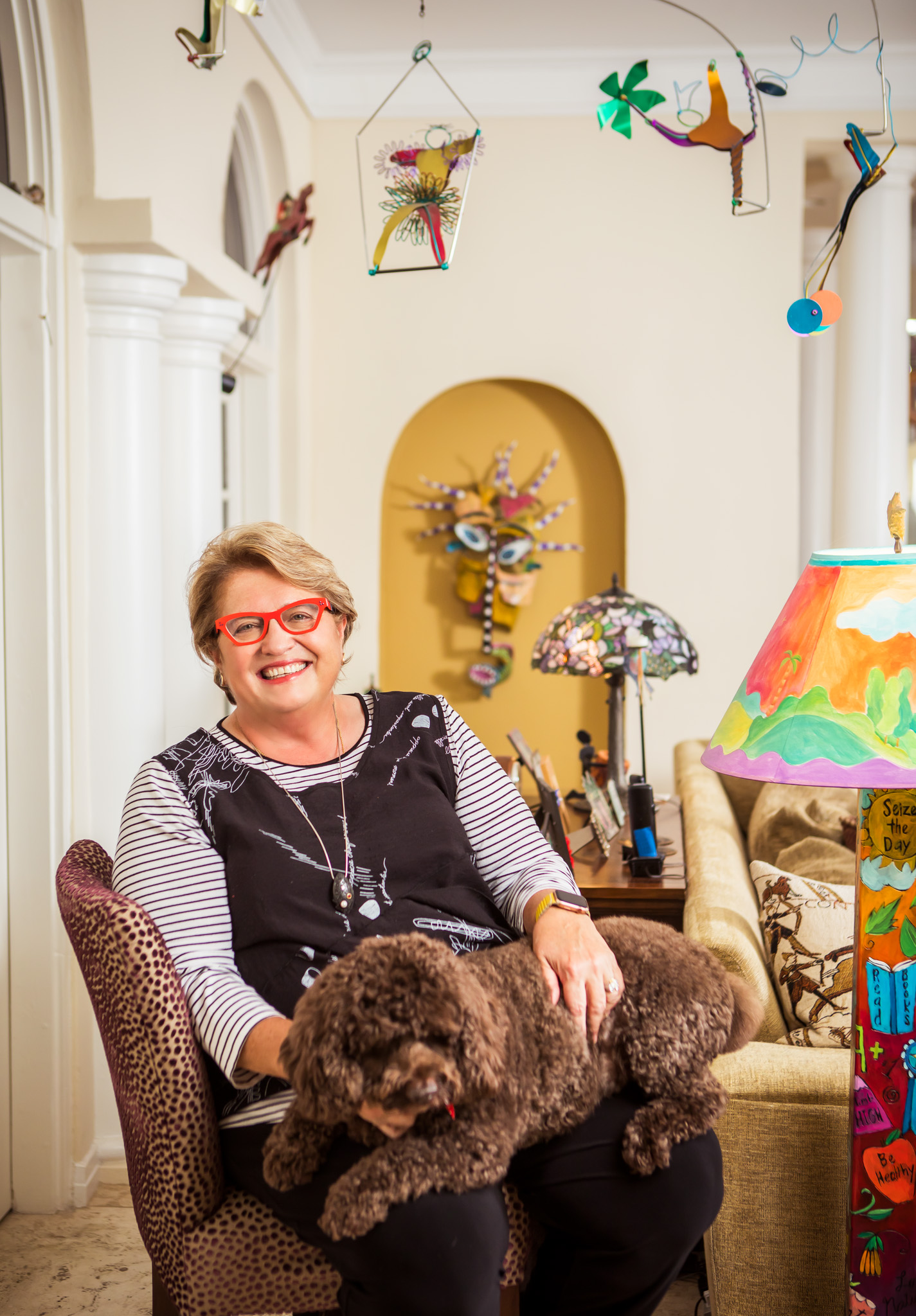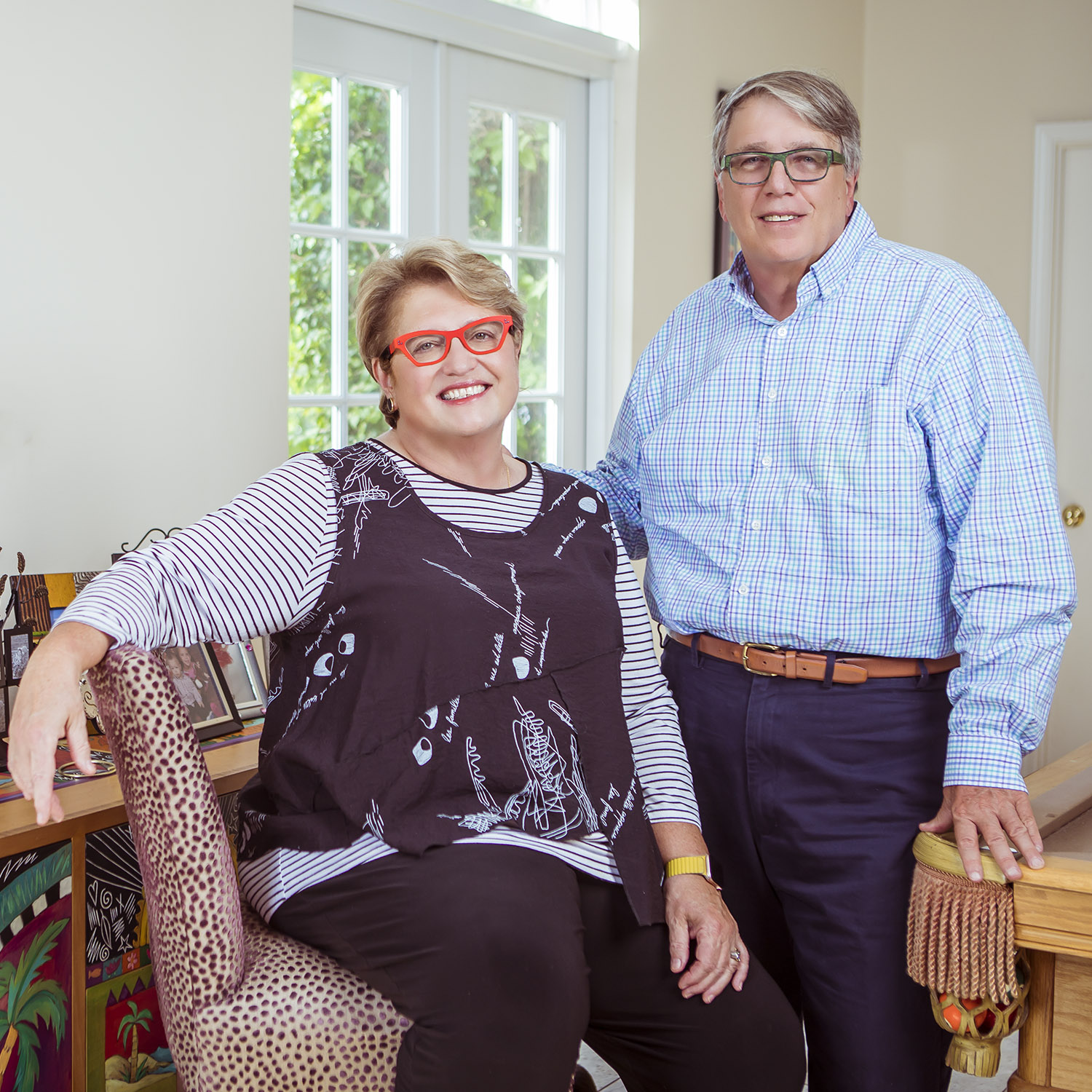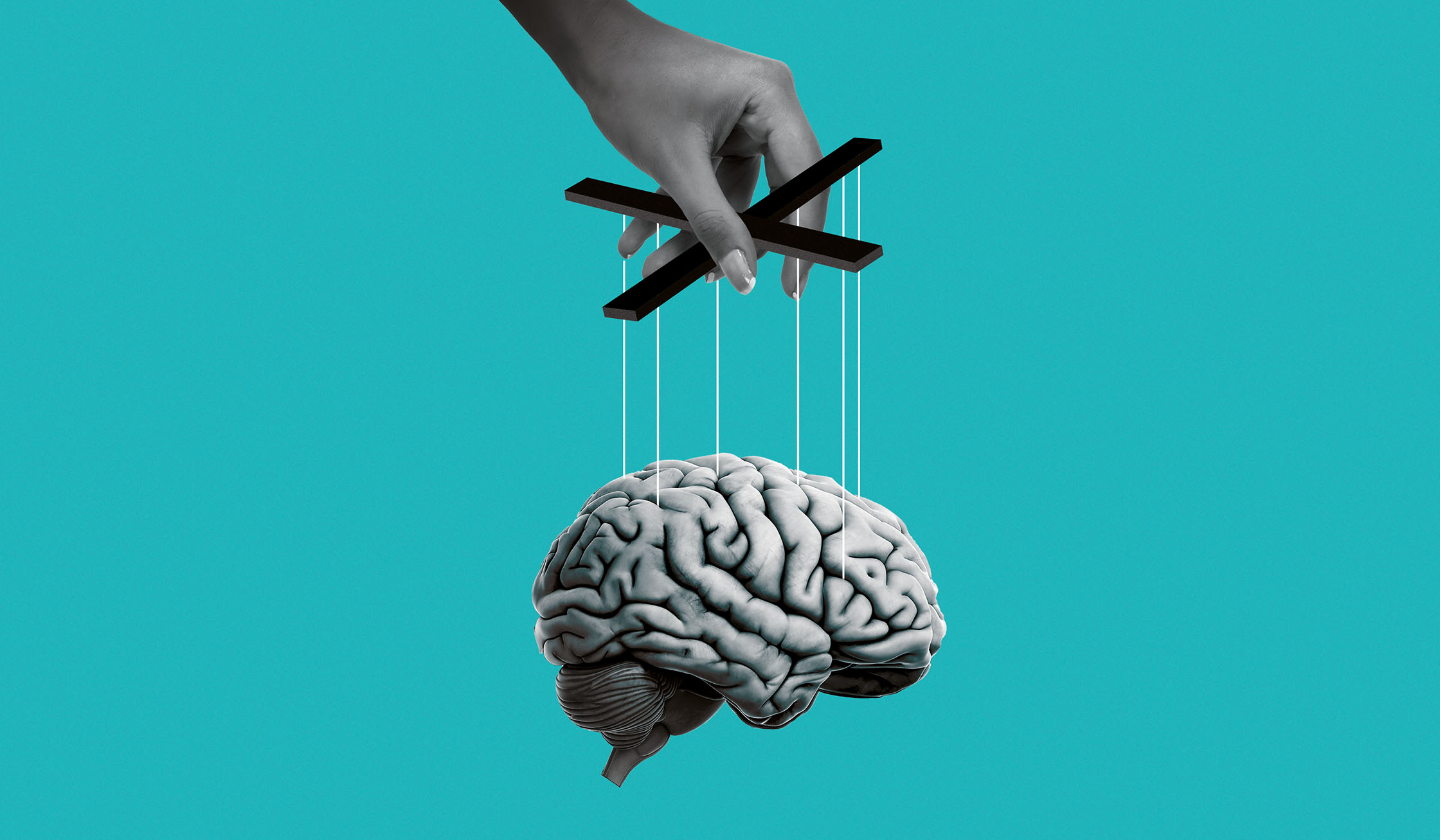Solving the Mystery
of Alzheimer’s
Miller School geneticist Dr. Margaret Pericak-Vance tells the story of her three-decade quest to unlock the secrets of dementia
Interview by Lisette Hilton
Illustration by LJ Davids
Photography by Sonya Revell
A
According to the Alzheimer’s Association, more than 5 million Americans are now living with Alzheimer’s disease. It is the sixth-leading cause of death in the U.S., where one in three seniors dies with it or another form of dementia as a complication. This year, Alzheimer’s and other dementias will cost the nation $305 billion, a figure that could rise to $1.1 trillion by 2050, when the number of people afflicted is projected to nearly triple, to 13.8 million, barring the development of medical breakthroughs.
Nowhere are those breakthroughs being sought more avidly than at the University of Miami Miller School of Medicine, where Margaret A. Pericak-Vance, Ph.D., continues to make an indelible mark in Alzheimer’s research. Dr. Pericak-Vance is director of the Miller School’s John P. Hussman Institute for Human Genomics (HIHG). Under her leadership, the HIHG is pursuing its mission to identify genes involved in human diseases in order to help diagnose, treat and prevent illness. The HIHG’s 30 faculty members cover a wide variety of disciplines and include some of the world’s top geneticists.
Dr. Pericak-Vance is also the Dr. John T. Macdonald Foundation Professor of Human Genetics and executive vice chair of the Dr. John T. Macdonald Foundation Department of Human Genetics. Her 200-plus-page CV and more than 740 publications reference research milestones in more than 30 diseases. Still, she is best known for her research work in Alzheimer’s disease, including a groundbreaking discovery in 1993 — a common variant, the E4 allele of the apolipoprotein E (APOE) gene, is the major risk factor (other than age) in late-onset Alzheimer’s disease. That discovery resulted in a landmark article in Science that is still the field’s most frequently cited paper.
Research achieving that level of professional respect also attracts significant financial support, and Dr. Pericak-Vance consistently generates NIH funding that puts her at the very top at the Miller School and in her field nationally.
We spoke with Dr. Pericak-Vance about how she came to do research in human genetics, where the hope lies for patients with Alzheimer’s, the Miller School’s global prominence in Alzheimer’s research, and oh, by the way, what’s up with all that colorful eyewear?
You grew up in Buffalo, N.Y. What started you down the path that brought you to Miami and your present status as one of the world’s preeminent genetics researchers?
My father was a social worker, who told me in no uncertain terms that he expected me to pursue higher-level education. He led me to believe I could accomplish anything.
During my sophomore year at Wells College in Aurora, N.Y., I took a course in genetics. Maybe I like tracing family histories because I am of Sicilian heritage and we are very family oriented, but my immediate reaction was “Wow! This is really cool.”
The father of one of my classmates ran the genetics lab at SUNY Downstate. I spent a month there as part of Wells’s 4-1-4 program. Cytogenetics was in its infancy in 1972. I found that I loved human genetics, and was particularly drawn to the analysis of genetic data, rather than working at a laboratory bench. I researched all the universities with programs in human genetics and ended up going to Indiana University Medical Center, where I graduated with a Ph.D. in medical genetics. It was there that I discovered genetic epidemiology, which uses genetic tools to try and understand the causes of human disease.
I worked under Dr. P. Michael Conneally, a true icon in the field, who ended up becoming my second father and best friend. My Ph.D. thesis was on the genetics of Huntington’s disease, which affects the brain, and started an interest in neurologic disease.

Margaret A. Pericak-Vance, Ph.D., with her cockapoo, Riley.
Indiana is also where you met your colleague and husband of 43 years, Dr. Jeffery M. Vance, who is professor of human genetics and neurology at the Miller School and the founding chair of the Dr. John T. Macdonald Foundation Department of Human Genetics. What is it like to be married to another high-achieving scientist who often collaborates with you in Alzheimer’s research?
[laughs] At least before the pandemic our offices were on separate floors! Now they are around the corner from each other in our home.
Although we do frequently collaborate on research projects, we decided early on that we didn’t want to overlap too much academically. When we left Indiana to go to North Carolina in 1978, I went to the University of North Carolina at Chapel Hill to do postdoctoral training in statistical genetics and genetic epidemiology under Dr. Robert Elston. I had become interested in neurogenetic disorders because of my work in Huntington’s. UNC’s department of biostatistics was probably the best in the country at the time, and Dr. Elston was the leader in the genetic epidemiology field.
After earning his Ph.D., Jeff did his postdoctoral work in muscular dystrophy research at Duke with Dr. Allen Roses, the chief of neurology at Duke. Following several years of postdoctoral fellowship, he applied and was accepted to medical school at Duke, where he subsequently completed his neurology residency and eventually became a full professor. I finished my postdoc at UNC, and in 1981, while Jeff was in medical school, I also went to work for Dr. Roses. I began working as a research associate in the Division of Neurology, and by 1999 I was a James B. Duke Professor of Medicine and director of the Duke Center for Human Genetics. I was one of the first Ph.D.s tenured in the Department of medicine at Duke.
When Dr. Roses hired me, he asked, “Do you think you can start a genetics research program in Neurology?”
I ended up at Duke for 28 years.
So where did you start?
I started in the Muscular Dystrophy Clinic, working with patients and their families, charting family histories. I was involved in early seminal findings in Duchenne Muscular Dystrophy, Myotonic Muscular Dystrophy, hereditary spastic paraplegia and Charcot-Marie Tooth-Neuropathy to name a few. I was out on maternity leave in 1984, when the National Institutes of Health decided to make available the first wave of Alzheimer’s research money.
When I came back, Dr. Roses said, “We are putting in for one of these large Alzheimer’s grants. Come up with a project.”
I suggested that we apply for a grant to look at the familial aspects of the late-onset form of Alzheimer’s disease. Alzheimer’s disease is a complex genetic trait that, with the exception of a few early-onset multigenerational Alzheimer’s disease families, was not thought to have a significant genetic component at that time. We got funded, and that is how I got into Alzheimer’s research. We also changed the thinking of the field, as we know now that genetic risk factors do significantly contribute to the risk for late-onset Alzheimer’s disease.
During my time at Duke I discovered the association of the APOE4 variant with risk and age-at -onset in Alzheimer’s disease. My group was also the first to identify that the E2 allele of the APOE gene protects against Alzheimer’s disease, and we published that in 1994 in Nature Genetics. I was extremely proud of this body of work and its impact in the field of neurogenetics. I believe it contributed to my election into the National Academy of Medicine in 2003.
A few years later, my collaborators and I discovered that a common coding polymorphism in the complement factor H (CFH) gene greatly increases the risk of developing age-related macular degeneration. This discovery, also published in Science, follows only the APOE4 discovery in terms of critical importance to the field of human genetics, as it confirmed the role of inflammation in age-related macular degeneration’s development. Then-NIH Director Dr. Elias Zherhouni said the discovery was one of the NIH’s most important breakthroughs of 2005. My laboratory also identified a variant of Interleukin 7 receptor alpha chain (ILR7) as a risk factor for multiple sclerosis. The NIH recognized the discovery as the most significant MS genetics breakthrough since the 1970s.
You and your husband moved to the Miller School in 2007. You became director of HIHG, and he became the founding chair of human genetics. With all your success at Duke, what led you to make that move?
Duke’s chair of medicine, Dr. Pascal J. Goldschmidt, left to become dean of the Miller School and wanted us to join him. There was more potential for growth for human genetics at the Miller School with the ability to start a new institute and a new department of human genetics.
What do you consider to be the most important findings since you came to the Miller School?
One was a paper in Nature Genetics that was a meta-analysis of data collected by four consortia that make up the International Genomic Alzheimer’s Project (IGAP). Dr. Brian Kunkle from the HIHG was the first author of the paper. It was the largest-ever Alzheimer’s gene study, which looked at 94,000 individuals of European descent.
Another paper would be the one in Neurology Genetics, with Dr. Holly Cukier of the HIHG as first author, which showed a unique deletion of the ABCA7 gene in African Americans. This common ABCA7 deletion could represent an ethnic-specific pathogenic alteration in Alzheimer’s disease and suggests ABCA7 is a more important gene contributing to Alzheimer’s risk in African Americans than it is in Europeans.
My original studies with my colleagues on APOE4 examined the effect in Europeans. Subsequently, when the risk to develop Alzheimer’s disease because of APOE4 was compared between African-American and European carriers of the APOE4 gene, it was discovered that APOE4 in African Americans contributed to much less risk for the disease than for Europeans. This was surprising at the time, and was not understood for many years. The monumental paper by Dr. Farid Rajabli of the HIHG, published in PLOS Genetics in 2018, explained why this difference occurred. It showed that something in the DNA surrounding the APOE4 gene, rather than the APOE protein itself, made the difference in risk and depended on the ancestral origin of the DNA.
The most recent paper, which just came out in JAMA Neurology, again with Dr. Kunkle as first author, is the largest African American genetics study ever performed. In it, we identify several new genetic loci and pathways associated with Alzheimer’s disease that are strongest in African Americans.

Margaret Pericak-Vance, Ph.D., with Jeffery M. Vance, M.D., Ph.D.
What would you say is your most important work going forward?
Much of my current work is dedicated to addressing health disparities in genomics research. It is critical that the therapies and treatments that come out during the coming years benefit all, and not just one segment of the population. We recently received an $18.8 million five-year NIA grant to lead research looking at how race and ethnicity impact Alzheimer’s risk and prevention. The first step is to learn how ancestries differ in their genetic risk for Alzheimer’s disease. This is important if we are to develop treatments that are going to benefit everyone. Studies have shown that drug targets based on genetic findings are twice as likely to develop into successful therapies as non-genetic targets. The next part will be making sure everybody has access to the therapies.
While many recent drug trials have failed, it has taught us that we must identify individuals earlier who are at risk for Alzheimer’s disease, to give us the best chance of successful therapy. The trials also taught us that we must look at all the ways Alzheimer’s disease affects the brain if we are to develop the most useful drugs.
Moving toward prevention makes sense — and not just in Alzheimer’s. It is true in most complex phenotypes or complex diseases where there is a later onset. It is much better to prevent the changes from happening.
Is there anything that stands out as a pathway or drug target?
The potential role of autoimmunity is one. Lipid pathway involvement has been known for some time, but we do not yet fully understand how lipids interact in the disease.
The great part is if you had asked me these questions 20 years ago, I would not have been able to say we are looking at this pathway and that pathway. Everything was based on the plaques and tangles. Now we are saying we must branch out in our thinking.
How is the Miller School viewed on a global scale in terms of Alzheimer’s research?
The truth is that the Hussman Institute is one of the major centers for genetics research in the world. I think it is obvious by, among other things, our involvement in international consortiums. I was one of the organizers of the Alzheimer’s Disease Genetics Global Symposium in September, which was supported by the Alzheimer’s Association and the National Institute on Aging. These were the top-tier people in the world, and there were five speakers from the Miller School Faculty at the HIHG. We were expecting 200 or 300 people to listen to the sessions and ended up having more than 1,600 people from 68 countries. I think that demonstrates the international impact of the work we are doing here in genetics.
You have consistently been extremely successful at generating financial support for your research. Last year, your projects received almost $16 million in NIH awards — making you consistently one of the highest-funded researchers in the Miller School and in the top two-tenths of one percent in your field nationally. What is your secret?
I really like what I do, and I must thank Dr. Allen Roses for teaching me about grant writing. I cannot overemphasize the importance of good writing in science. Both in papers and grants, you have to be able to tell a story that makes sense to the reader, usually someone who is not an expert in your field. Like a good novel, they have to be able to follow the plot and the reasoning behind it. All scientists need to hone their writing skills in college and beyond.
Your group also just received a $7.6 million NIH grant for a tissue biorepository. How will that assist your research?
Dr. Jacob McCauley [associate professor in the Dr. John T. Macdonald Foundation Department of Human Genetics and director of the Center for Genome Technology and its biorepository facility at the Hussman Institute] took the initiative and wrote a NIH grant application to build a new facility, and it was funded. I am extremely proud of Jake. We already have one of the largest academic biorepositories in the country, but there is so much more we could do. The new facility will have two large, robotic freezers that will dramatically increase sample storage capabilities, enhance biosecurity and accelerate sample retrieval. We will have better tools for studying Alzheimer’s and many other diseases and conditions.
Today nearly half of the HIHG faculty members are women. Have you seen that change over time during your career? How did you deal with being a female in a scientific profession?
My philosophy has always been to try to be the best at whatever I do. Dr. Barton Haynes, director of the Duke Human Vaccine Institute and my former chair at Duke once gave me great advice. He said, “Peggy, if you are the best at what you do, they will have to listen to you.” I have always strived to follow his advice.
Something that no one can ignore is your colorful eyewear.
You should see my collection! I have about 30 pairs of glasses. I am dying right now because I don’t get to show them off. I can only wear them on Zoom meetings. Thank goodness for Bascom Palmer and my employee discount on lenses. I love my glasses.
What would you tell someone just starting out in the field of Alzheimer’s research?
I would tell them to discard the thinking that one person can do it all. You have to be collaborative. Alzheimer’s is so complex that there is no way one person can know every aspect, every field and subfield that is involved. Part of being a good researcher is realizing what you do not know and how to take what you do know and maximize it by working with others that know what you don’t.
When I first started, people worked in small individual labs, doing their individual experiments. Today’s technology makes sharing and collaboration imperative. I would never have believed even 10 years ago that we would be sharing information across the world.
I also think we need to acknowledge that in addition to the NIH, there are many national and international foundations, as well as private philanthropists, contributing to the funding that is a key to our recent advances.
This is the most exciting period in research that I have ever experienced because there are so many opportunities. At every turn there is something new, something developing. I really think that we are going to be able to find therapies that will make a difference. We are almost there. ![]()



